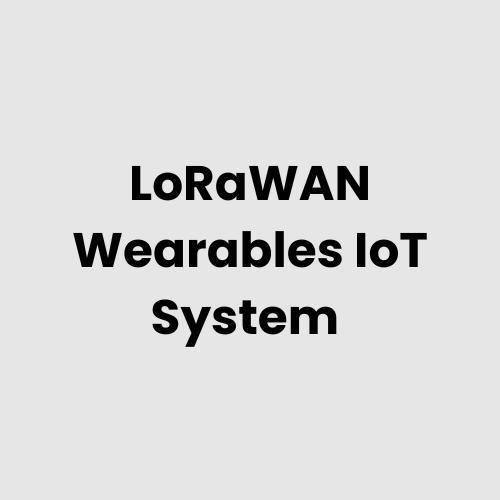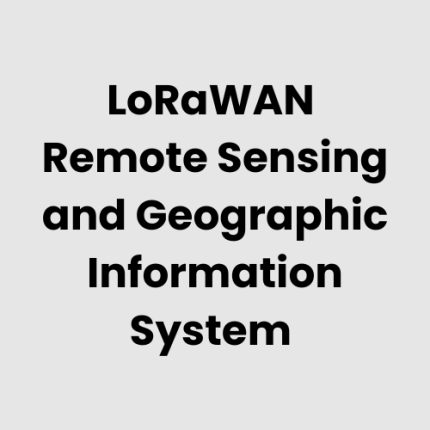Description
Technical Architecture of LoRaWAN Enabled Wearables IoT System
The LoRaWAN Enabled Wearables IoT System operates by utilizing low-power wide-area network (LPWAN) technology to connect wearable devices to a central network. The architecture consists of wearables (sensors and trackers), LoRaWAN gateways, a network server, and cloud-based or local data management systems. These elements work together to transmit health, location, and environmental data from wearables to the server for analysis, ensuring real-time monitoring and efficient data usage.
Hardware of LoRaWAN Enabled Wearables IoT System
- Wearable Devices: Equipped with sensors to collect health data such as heart rate, step count, body temperature, or location data.
- LoRaWAN Transceivers: Integrated into the wearables to transmit data to LoRaWAN gateways.
- LoRaWAN Gateways: These devices receive the data from the wearables and forward it to the network server for further processing.
- Network Server: The backend infrastructure for managing the communication between wearables and cloud systems.
- Cloud Storage: Stores processed data for analysis and reporting purposes.
- Charging Stations: Ensure the wearables remain operational during prolonged use, integrating wireless charging capabilities.
Physical Placement Considerations of LoRaWAN Enabled Wearables IoT System
The placement of the hardware should be optimized for optimal connectivity and user comfort:
- Wearable Devices: Typically worn on the body, such as wristbands, smartwatches, or body patches, providing continuous monitoring without interference in daily activities.
- LoRaWAN Gateways: These should be placed in areas with a clear line of sight and in proximity to where large groups of wearables will be active (e.g., offices, fitness centres, medical facilities).
- Network Servers: Ideally located in secure data centres with robust internet connectivity to ensure constant communication and data processing.
- Cloud Servers: These are hosted remotely and can be accessed globally, providing scalability and flexibility for system expansion.
Hardware Architecture of LoRaWAN Enabled Wearables IoT System
The hardware architecture for the LoRaWAN Enabled Wearables IoT System is designed for seamless communication between sensors and servers. The wearable devices are equipped with LoRaWAN modules that send periodic data to the nearest LoRaWAN gateways. The gateways relay the data to a network server, which manages the communication and ensures data flow to either local or cloud-based databases. The system architecture also supports real-time alerts, remote device management, and data analytics, ensuring the optimization of wearables’ functionality and performance.
Deployment Considerations of LoRaWAN Enabled Wearables IoT System
When deploying a LoRaWAN-enabled wearables system, several factors must be considered:
- Coverage Area: The range of the LoRaWAN network must be mapped, and sufficient gateways need to be placed to ensure all wearables can transmit data effectively.
- Network Security: Security protocols must be integrated into the system to ensure that data is encrypted during transmission and stored securely.
- User Experience: Wearables should be comfortable and user-friendly, ensuring that they are easy to wear and provide reliable data collection.
- Battery Life: Long battery life is crucial, so low-power sensors and efficient power management protocols should be employed.
- Regulatory Compliance: The system must comply with regional regulations regarding wireless communication and data privacy.
List of Relevant Industry Standards and Regulations
- IEEE 802.15.4
- LoRaWAN Protocol Specification
- General Data Protection Regulation (GDPR)
- Health Insurance Portability and Accountability Act (HIPAA)
- ISO/IEC 27001 (Information Security Management)
- European Telecommunications Standards Institute (ETSI) Standards
- Federal Communications Commission (FCC) Regulations
- The Radio Frequency Spectrum Management Regulations
Local Server Version (Running with a Local Server)
For applications requiring data processing and storage closer to the source, a local server deployment is an option. This configuration enables the wearable data to be transmitted to an on premise server, reducing latency and allowing for immediate processing and feedback. GAO Tek’s solutions ensure robust integration with local servers, allowing for complete control over data access and security. The local server can integrate with other enterprise systems for streamlined data management and real-time analytics.
Cloud Integration and Data Management
LoRaWAN-enabled wearables can be integrated with cloud platforms, enabling real-time data access, storage, and analytics. Data collected from the wearables is transmitted to a cloud server, where it can be processed, analysed, and stored securely. Cloud services offer the advantage of scalability, allowing for large volumes of wearable data to be processed and stored with ease. The cloud system can provide insights, generate reports, and send real-time alerts based on the data received. GAO Tek’s IoT solutions enable seamless cloud integration, ensuring easy management and access to data remotely.
GAO Case Studies of LoRaWAN Enabled Wearables IoT System
United States Case Studies
- New York, NY
A healthcare provider in New York implemented wearable IoT devices with LoRaWAN technology to monitor patient vitals in real-time. The system allowed for continuous tracking of heart rate, temperature, and activity, improving patient care while reducing response times for medical staff.
- Los Angeles, CA
In Los Angeles, a fitness company integrated wearables using LoRaWAN to track user performance during group fitness classes. The system enabled real-time feedback for participants, while providing detailed data analysis for instructors to optimize training programs.
- Chicago, IL
A large enterprise in Chicago adopted LoRaWAN-enabled wearables for its employees, ensuring real-time location tracking and health monitoring. This initiative enhanced workplace safety, providing immediate alerts in case of health emergencies and enabling efficient workforce management.
- San Francisco, CA
A wearable tech start up in San Francisco implemented LoRaWAN to track health metrics in seniors living independently. The solution helped family members and caregivers monitor vital signs remotely and ensure prompt assistance in emergencies.
- Boston, MA
A Boston-based university used LoRaWAN-enabled wearables for students in a campus-wide wellness initiative. The system gathered health data to support wellness programs and provided personalized health insights to students, while ensuring privacy and data security.
- Miami, FL
A sports team in Miami integrated LoRaWAN wearables for player performance monitoring during training sessions. The wearables tracked various physical parameters, giving coaches real-time data to adjust training and improve performance outcomes.
- Dallas, TX
In Dallas, a government agency deployed LoRaWAN wearables for personnel working in hazardous environments. These wearables monitored environmental conditions and health metrics to ensure the safety of workers in extreme conditions, triggering alerts for immediate action if necessary.
- Seattle, WA
A Seattle-based Logistics Company employed LoRaWAN wearables to track the health and activity of delivery drivers. The system helped ensure driver safety and compliance with health standards, particularly in remote areas with limited connectivity.
- Atlanta, GA
In Atlanta, a healthcare facility utilized LoRaWAN-enabled wearables for real-time monitoring of patient movements and health data. The system improved patient outcomes by enabling timely interventions and reducing emergency incidents.
- Houston, TX
A tech company in Houston adopted LoRaWAN wearables to improve the safety of employees in high-risk areas. The devices provided continuous health and location data, helping to prevent accidents and enabling rapid response in case of emergencies.
- Phoenix, AZ
A Phoenix-based research institute used LoRaWAN wearables to gather environmental and biometric data from researchers conducting fieldwork in remote areas. The wearables provided real-time information, ensuring researchers’ health and safety during critical data collection missions.
- Denver, CO
A construction company in Denver integrated LoRaWAN-enabled wearables for site supervisors and workers to monitor health conditions, environmental factors, and safety metrics. This solution provided real-time alerts for potential hazards, improving overall safety compliance.
- Washington, DC
A national fitness chain in Washington, DC leveraged LoRaWAN wearables to enhance client experiences during fitness assessments. The wearables tracked individual workout data, allowing trainers to offer customized plans and helping members achieve their fitness goals.
- Detroit, MI
In Detroit, an automotive manufacturer adopted LoRaWAN wearables for tracking assembly line workers’ health and productivity. By collecting data on physical performance and well-being, the company was able to enhance workforce efficiency and reduce injury rates.
- Minneapolis, MN
A Minneapolis-based hospital system deployed LoRaWAN wearables to monitor new-borns in neonatal units. The wearables provided constant vitals monitoring, alerting staff to any irregularities or health concerns, significantly improving the care of fragile infants.
Canada Case Studies
- Toronto, ON
A healthcare organization in Toronto implemented LoRaWAN-enabled wearables for remote patient monitoring. These devices tracked key health indicators like blood pressure and glucose levels, allowing healthcare professionals to intervene promptly and manage chronic conditions more effectively.
- Vancouver, BC
In Vancouver, a logistics company used LoRaWAN wearables to monitor the health and safety of workers in remote locations. The wearables tracked vital signs, sending real-time alerts if abnormal health data was detected, thereby ensuring quick medical intervention and reducing workplace risks.
Navigation Menu for LoRaWAN
Navigation Menu for IoT
- LORAWAN
- ZIGBEE
- Wi-Fi HaLow
- Z-WAVE
- BLE & RFID
- NB-IOT
- CELLULAR IOT
- GPS IOT
- IOT SENSORS
- EDGE COMPUTING
- IOT SYSTEMS
Our products are in stock and can be shipped anywhere in the continental U.S. or Canada from our local warehouse. For any further information, please fill out this form or email us.
We are actively looking for partners who are like us located in the U.S. and Canada. For more information on partnering with GAO, please visit Partner with GAO Tek Inc. It lists various ways to partner with GAO, such as OEM Partnerships, Technology Integration, Distribution and Reselling Opportunities, Presenting at the Leading Event Tek Summit, Joint R&D Projects, Training and Consulting Services, Industry-Specific Collaborations, Research and Academic Partnerships.



